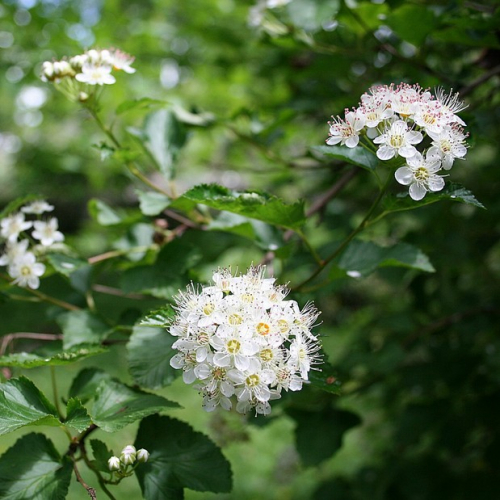Deciduous bushes Physоcarpus

Description
Characteristic Features of Physocarpus
Physocarpus (Ninebark) is a genus of deciduous ornamental shrubs in the rose family Rosaceae. Physocarpus is native to North America and East Asia and is cultivated as an ornamental plant all over the world because it is very easy to keep.
Both the Latin name and the Russian name (the "bladder fruit") refer to the unique inflated fruit of the plant.
An average height of the shrub is 2-3 metres but there are dwarf varieties not exceeding one metre tall. Physocarpus looks attractive not only during blooming but throughout the season. Its large serrated leaves range from green to golden to magenta, depending on the species. The bark on the branches is untypically flaky, which makes the plant even more attractive. The flowers are small (about 1.3 centimetres across), typically white or pink, and arranged in umbelliform inflorescences. Flowers are borne in early or mid-summer and lasts for 3-4 weeks. The fruit is an inflated follicle, very ornamental and changing colour from reddish to terracotta when mature.
The genus comprises about 15 species but only two species are used for landscaping:
Asian Ninebark (Physocarpus amurensis) reaches 3 metres tall and has a spherical crown, three- to five-lobed leaves that are deep green on the upper surface and greyish on the underside, and small white flowers collected in umbellate inflorescences. Growers especially value the following varieties: 'Luteus' with the leaves golden in the summer and bronze in the autumn, 'Aureomarginata' with a golden margin on the leaves, and 'Nana', a low shrub with bright green leaves.
Common Ninebark (Physocarpus opulifolius) grows to 3 metres tall and has a spherical crown, drooping branches, serrated rounded leaves, middle-sized white or pink flowers, and attractive fruits, changing their colour. This species also has a few cultivars varying in foliage colouration: 'Dart's Gold' with the leaves that stay bright yellow throughout the season, 'Purpureus' with purple leaves, 'Aureus' with the leaves yellow-orange in the spring and autumn and green in the summer, 'Red Baron' with deep red leaves, and 'Summer Wine' with burgundy leaves turning green in the summer. It should be noted that Physocarpus opulifolius is commonly mistaken for the Meadowsweet and Spiraea opulifolius. These are different plants, though related.
In landscaping, Physocarpus is used in single and group plantings. Low-growing varieties are cultivated mainly in Japanese gardens an rockeries. Hedges of this plant are also very attractive.
The Secrets to Successfully Growing Physocarpus
This shrub is not fussy about soils bit it does not like calcareous soils, though. It can grow well in the shade and is drought- and frost-resistant. Physocarpus does not tolerate soggy soils and waterlogging and needs good drainage.
Physocarpus tolerates air pollution, which makes it perfect for planting along highways and in large cities.
Varieties with bright coloured leaves need to be planted in full sun, as the beauty of the purple and gold hues will not be to its fullest in the shade.
In the dry season, water Physocarpus sparingly, twice a week on average. The amount of water depends on the climate and the soil type. You should also loosen the soil 5 centimetres deep and remove weeds. If Physocarpus grows in depleted soils, use compound fertilizers in the spring and autumn.
Physocarpus grows rapidly, adding about 30 centimetres per year. For the shrub to look lush and beautifully shaped, prune the branches every year, best in the spring, especially in young plants. An undoubted advantage of this ornamental shrub is its winter hardiness. Only very young plants require winter sheltering.
In the garden, Physocarpuses are best grown from seedlings with a covered root system. Typically, these plants are sold in special containers. Plant out in late spring, in the summer or early autumn. Dig a planting hole 50x50 centimetres, put a layer of drainage material at the bottom, carefully remove the seedling from the container, making sure not to damage the roots, put it into the hole, and fill in with fertile soil (the best mix is loam, peat, and sand). Keep the root collar no deeper than 5 centimetres. Water the seedling plentifully and mulch with a 5 centimetre layer of peat.
Physocarpus can be propagated by seed, cuttings, layering, and division. Sow the seeds before winter or in the spring after one-month stratification. However, propagation by seed is not common, as only some plants maintain the original bright golden or burgundy foliage colour, while in others the foliage colour blurs or gets solid green.
To propagate Physocarpus by layering, remove leaves from a healthy outermost shoot (except for apical leaves) and pin it to the ground in a small hole, for example, by using wooden brackets. For successful rooting, the cuttings require regular watering, especially in dry weather. In the autumn, separate cuttings from their mother plant and winter shelter.
Propagation by cuttings is used more frequently. Cut current year's green shoots in the summer, dip them in growth promoter, and root in a shady location with fertile soil. It is better done in the greenhouse than in open ground, as young plants can freeze in the winter. Cuttings need to be regularly watered and occasionally aired. The following spring, transplant the cuttings to a permanent location, spacing about two metres apart.
Potential Problems
Although Physocarpus is fairly disease-resistant, in waterlogged soil it can be affected with powdery mildew, a fungal disease causing grey spots on the shoots. Adjust the watering schedule and treat badly infected shoots with fungicides.
Shortage of nutrients in the soil may cause chlorosis.
Sometimes chimera leaves can develop (mosaicism). This is not a disease. The following year, the foliage will get back to its normal colouring.







 83 826
83 826







